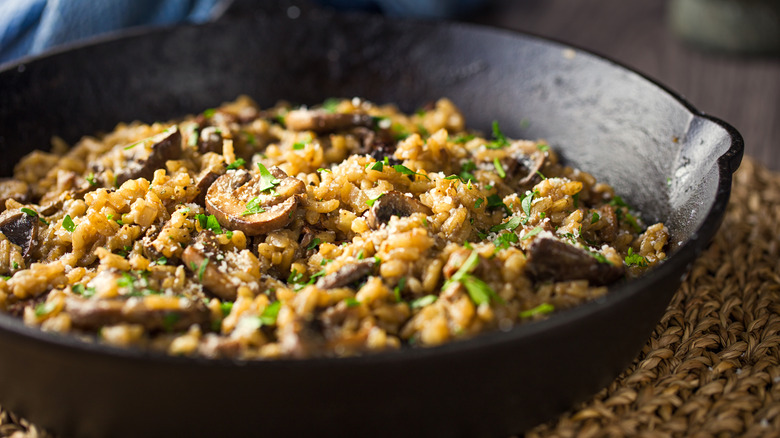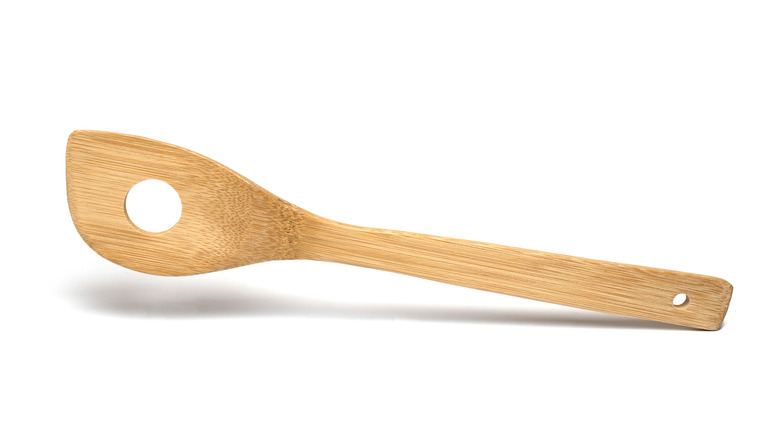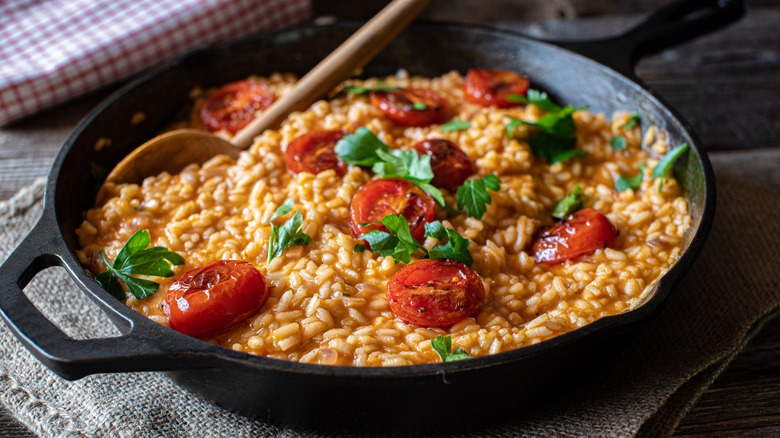Why A Perforated Spoon Is Critical For Making Perfect Risotto
If you've ever attempted it at home, you know there are a host of mistakes you can make with risotto. Whether you're whipping up a simple morel mushroom risotto or putting together something a little fancier like seared scallops with basil risotto, the basics are always going to be the basics. You need a proper short-grain rice like arborio, a delicious stock, maybe a little white wine, and a perforated spoon. You were probably following all this until "perforated spoon", but rest assured this is the key to getting your risotto to turn out a nice, creamy rice dish instead of a gloopy, starchy porridge. Why? Because this spoon with a hole in it actually prevents too many grains of rice from being broken during stirring.
The spoon in question does, in fact, have a giant hole in it — which at first glance seems counterintuitive. In Italy, the spoon is called a girariso (which translates to "rice rotator"), and its design is meant to help it move smoothly through rice and soups without breaking things up too much and ruining the texture of your dish.
Stir, don't break
When making risotto you have to stir pretty frequently but not constantly — contrary to what many people believe. As you ladle hot broth every few minutes for the arborio to absorb, you'll want to incorporate the stock for more thorough cooking. Stirring is crucial for this reason, but it also activates the natural starches in the arborio. Arborio rice is naturally high in amylopectin starch which gives it that creamy, dreamy texture making it perfect for risotto as well as rice pudding. It also absorbs a lot more liquid than short-grain rice, which is why it takes so long for it to cook.
For all the things that make arborio delicious and beautiful, it can also be the reason for its ruin. If you overwork the rice, it will break down into gluey gruel. That's why the girariso is ideal for risotto; it helps the grains of rice pass through the center of the spoon without too much breakage, while pushing the liquid in the opposite direction of the grains, helping the distribute stock and starch evenly around the grains. Additionally, the risotto spoon in the flat, slightly-angled edge which comes in handy for keeping rice off the bottom of the pot, where it will tend to stick and burn.
Girariso, the wonder spoon
Italians use their girariso for more than just risotto. These holey spoons are handy for folding fragile cake batters and mixing pastry cream — and pretty much anything that requires the lift of added air, either for volume or leavening. Creme anglaise is a perfect example of a dish where a risotto spoon can be ideal for helping to lighten the consistency. Because the creme is lighter than milk but doesn't require whipping like traditional whipped cream. The eggs can pass through the middle of the girariso smoothly — think of it somewhere between whipping and beating. Joconde sponge is another dessert that could benefit from the use of a girariso, or any delicate sponge you're making.
If you don't have a risotto spoon to hand, you can definitely still make risotto. But you'll want to be mindful of how delicate the grains are, perhaps a light whisk with wide-set wires is an elegant alternative to the girariso. If you do find yourself replacing your wooden spoon set in the near future — which (at least according to Martha Stewart) you should be doing every five years – maybe you'll consider adding that goofy-looking hole spoon to the collection.


